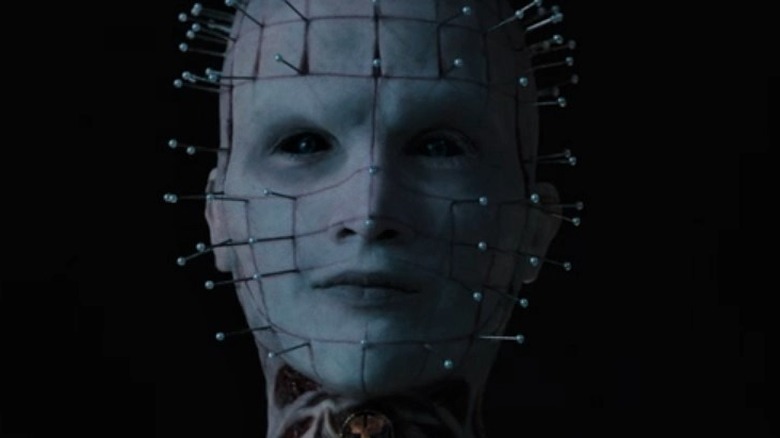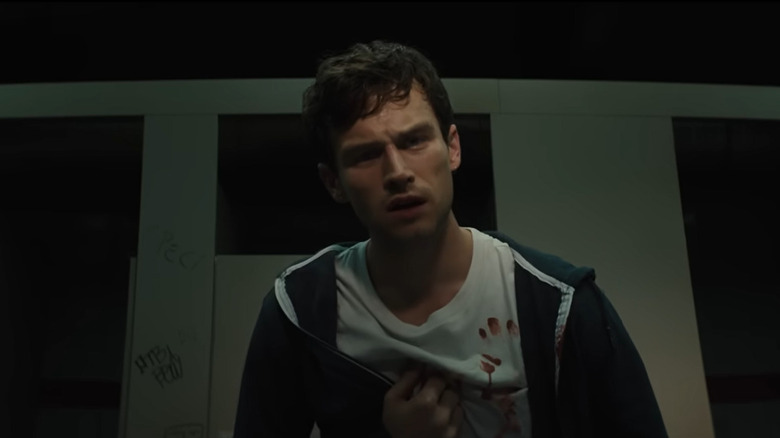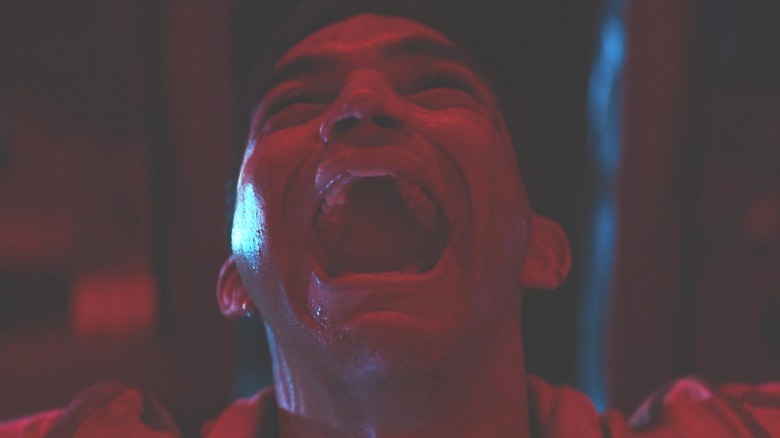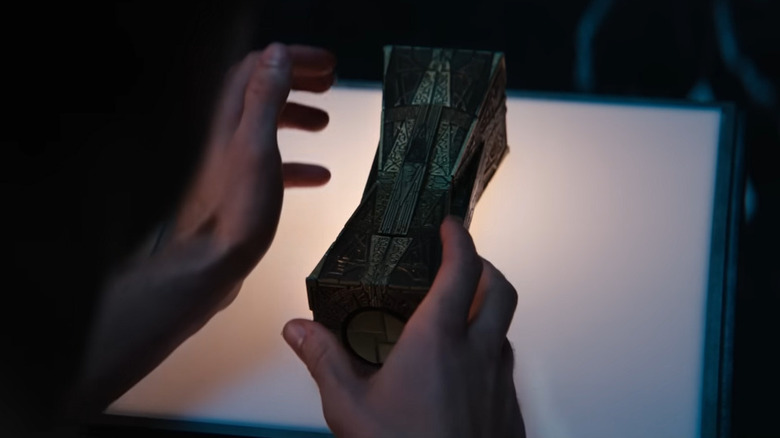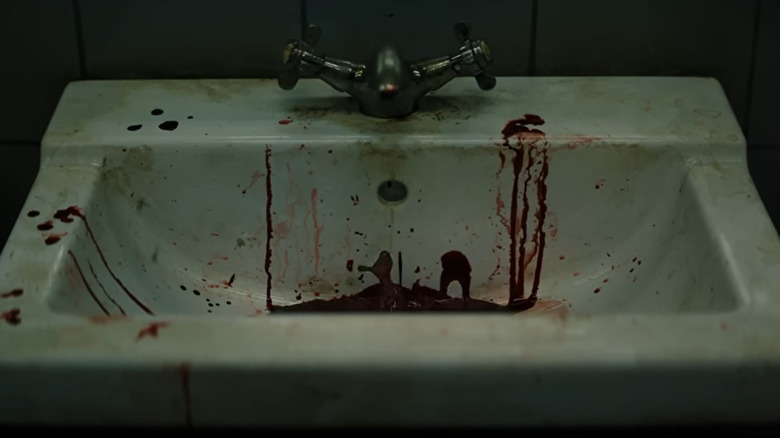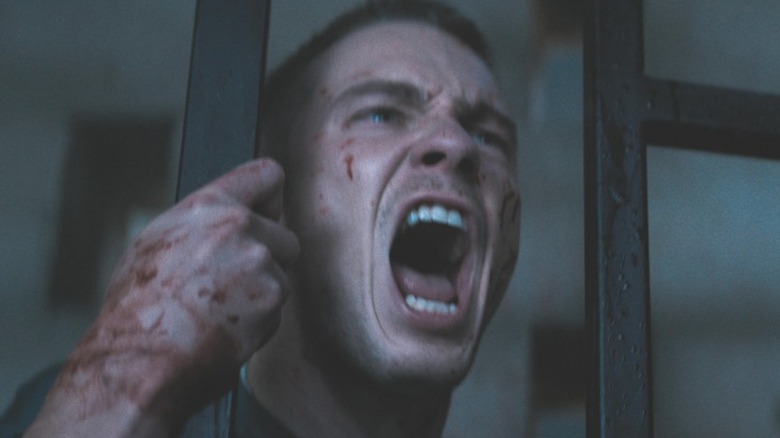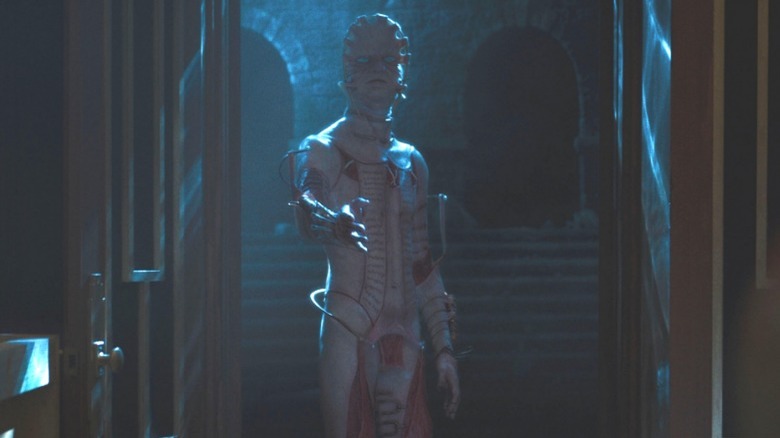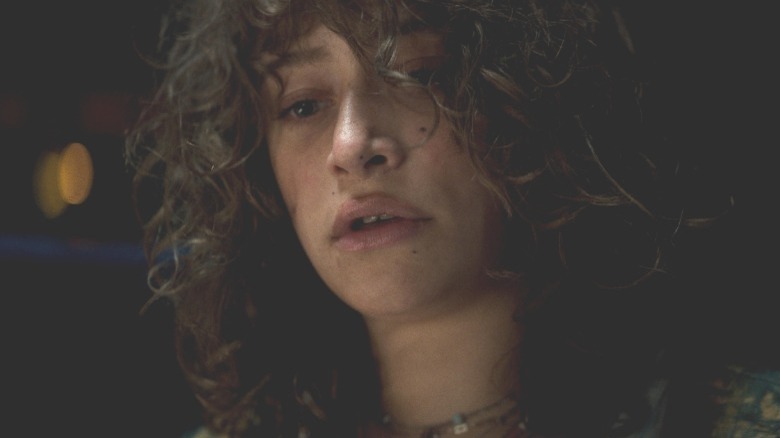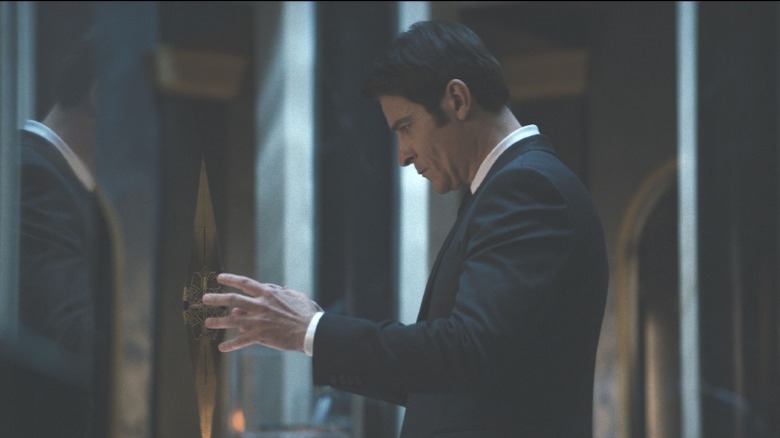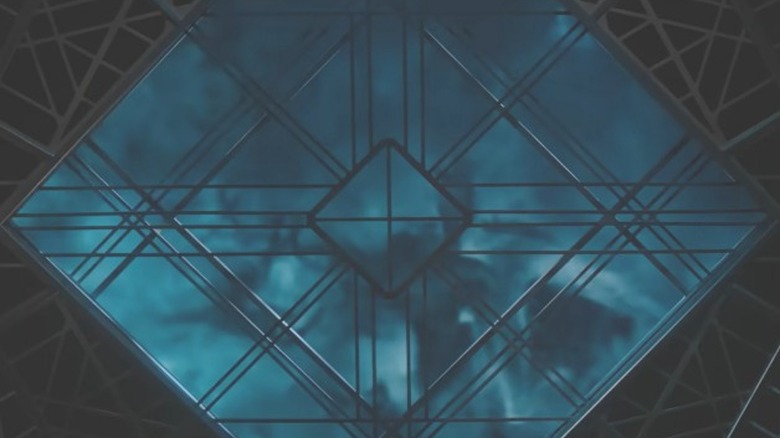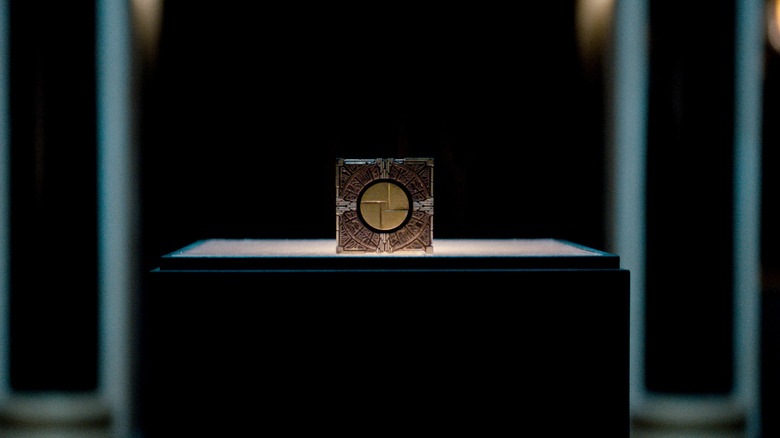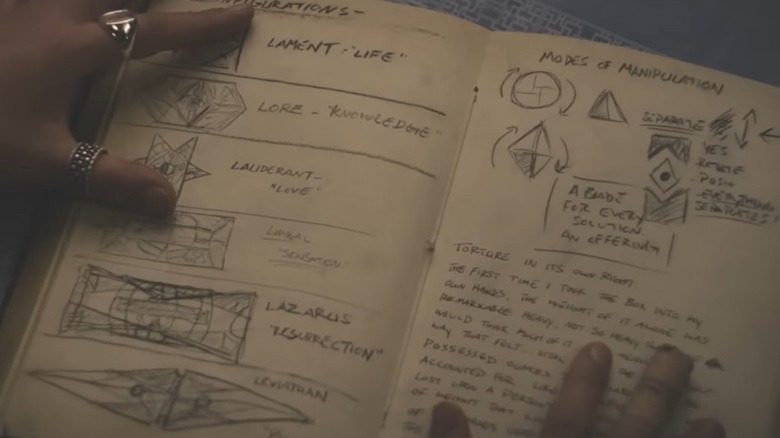The 12 Most Disturbing Moments In Hulu's Hellraiser Ranked
This article contains spoilers for the new Hulu movie "Hellraiser."
The wait is over and the much-anticipated "Hellraiser" 2022 reboot is finally here. Did you enjoy it? How did you prepare for it? We got ready in the usual way: By combing Looper for secrets about the "Hellraiser" franchise and making sure we know where we can watch all the films, including Hulu's newest reboot.
And anticipation was high. Not only is "Hellraiser" a beloved series, but the first two films (at least) are recognized horror classics. There's something undeniable about the story's mix of brutality, sensuality, and cleverness — and something wicked about its sense of humor and fairness.
Because in Clive Barker's world, there really isn't much fairness to be had. On the largest possible cosmic scale, things might work out. But down here among the little folk, you're as likely to be stepped on by a giant as you are to become one: It's a cold universe, full of dangers and darkness, with that added noir flair that says, "Nobody in this movie is going to do the right thing."
Even the heroes, like Kirsty in the first two films, regularly end up sacrificing their antagonists to the Cenobites. And while that's not exactly how the story ends here, it's safe to say there will be few "good guys" left by the end...
12. Matt returns
Looking for answers about her missing brother, recovering addict Riley (Odessa A'zion) finds her way to the art deco home of a famously debauched– and missing — art dealer named Roland Voight (Goran Visnjic). Our assumption is that the Cenobites have finally gotten to him, and as we'll see, we're mostly right about that, if not about the conclusion of their visit.
Once Riley breaks into the mechanized house, she's visited by a shade of her brother Matt, who has long since been taken by the Cenobites. Embracing him, she feels the torn flesh of his back, where the chain hooks got him, and he whispers, "Bring me back."
This is particularly disturbing because it tells us this story is going to the same places as the original films ("Hellraiser" and "Hellbound: Hellraiser II") that are most clearly based on Clive Barker's "The Hellbound Heart." In both those films, an obsessed lover kills strangers in order to bring their beloved back to a nasty kind of life.
Will Riley kill strangers — or friends — to get her brother back? Or will she fall prey herself to the mysterious puzzle box that took him from her?
If you or anyone you know needs help with addiction issues, help is available. Visit the Substance Abuse and Mental Health Services Administration website or contact SAMHSA's National Helpline at 1-800-662-HELP (4357).
11. Matt's visitation
Matt (Brandon Flynn) and his boyfriend Colin (Adam Faison) are cozying up in bed, clearly in love but worried about Matt's sister. She's off playing around with the ancient LeMarchand puzzle box and doing drugs from a stash in her car. As Riley dreams of opening the box in a certain way that sends more chains out of her body, we return to Matt's bedroom, where chains hook him from all sides, tearing horribly at his flesh. Matt awakens, breathing heavily, with no idea he's just been warned about the Cenobites.
In other "Hellraiser" films this is a common cinematic trick: To demonstrate that a character is in danger from the hellish forces the Cenobites represent, they will have a realistic dream about being killed by them. In this case — with so few scary scenes this early in the film — Matt's death seems particularly likely. Unfortunately it also plays into the "Bury Your Gays" trope, in which queer characters are often portrayed as little more than one-dimensional victims of violence.
That's a troubling way to start the movie, and when Matt is revealed to be just dreaming — for now — it's more of a relief than it might be otherwise.
10. First blood
In the beginning of the film, a young, handsome sex worker makes his way through a raunchy party, where the elites have come to celebrate with drugs and lots of sex. He comes to an art gallery of sorts, in which plenty of occult items are visible. He finds a puzzle box, which has changed for now into a long rectangular shape. He is mesmerized by it and picks it up, beginning to solve the puzzle for its next configuration, when Roland Voight enters the room.
When the young man asks a pleased Voight whether solving it will earn him a prize, Voight laughs and says he's the one who will get the prize. As we'll see by the end of the film, Voight has a particular destination in mind for himself that is new to the series. The box clicks, sending a small curved knife out into the young man's flesh. We'll come to know this as the method by which the Cenobites find their victims: Get stabbed by the LeMarchand box and it's all over for you.
As a first kill, this one's pretty dramatic: First his hand is sliced up by the box, then Voight does something to lock him into the vault room. Then chains begin emerging from the walls, tearing into his flesh and eventually pulling him up into the air before ripping his body apart. We don't see what happens to Voight at this point, but it's also not good.
9. Matt's doom
In this version of the story, the LeMarchand box has seven configurations with seven different purposes — which gives new meaning to the puzzle box's classic cubical silhouette, also known as "the Lament Configuration."
We'll learn more about its operation throughout the film, but about 30 minutes in we've only seen one visit from the Cenobites and Riley hasn't figured out anything about the box or how it works. In fact, the bloody gash on her brother's hand seems like almost an afterthought once he touches the box and it stabs him — we are meant to assume that the Cenobites will be coming to rip him apart soon.
Matt bleeds all over himself and runs into a public toilet to wash his hands. Outside on the ground, where Riley threw it, the box begins once again to solve itself, twisting and turning its clockwork mechanisms. Back in the bathroom, there are flickering strange lights and blood is bubbling up from the sink.
We hear the chains arrive and presumably do their business, but when Riley goes to find her brother, all that remains is a bloody handprint. He has disappeared, if not died alone, and the rest of the movie will see Riley trying to rescue him from death itself.
8. The final sacrifice
Riley watches as the Flayed Nun's piano wire climbs up and around her boyfriend Trevor's (Drew Starkey) body, choking him and finally skinning him and ripping him apart. By this time we know about Trevor's betrayal — that he was working with Voight the whole time, for reasons that may not become clear — and it's perhaps a little satisfying to see him get his just desserts.
Mostly, though, it's visually upsetting: We haven't seen too many people flayed yet in the film, and the wire takes its time as it takes Trevor apart. We also have the added menace of the Flayed Nun and other Cenobites standing by, ready to attack. So while it's a kind of justice, it's not exactly a relief.
People in recovery are often told not to start relationships with each other (via American Addiction Centers), which is why Riley and Trevor's relationship is frowned upon by Matt and their friends. The fear is that they will turn their addictions onto each other, becoming codependent or worse. In this case, the danger was more that Riley's boyfriend was secretly working with a powerful, depraved millionaire to kill her and her friends in pursuit of his prize.
7. Serena's visitation
At around the halfway point of the film, we get our first real visitation from the Cenobites in all their splendor. Serena (Hiam Abbass), who gathered souls for Voight in his pursuit of the Cenobites, is dying in a hospital when she accidentally stabs herself with the LeMarchand box. Knowing it's only a matter of time before Hell arrives, Serena buckles up for what's to come. The lights begin to flicker and we see the Flayed Nun's naked back and spinal column for the first time.
Serena runs past a hallway which has just opened up out of the walls, where a 10-foot pole with various swatches of flesh hanging from it rotates horribly. All the doors are locked. Finally three of the Cenobites converge on Serena out of the gloom, and it's our first good look at them — including The Priest (Jamie Clayton), aka Pinhead. She is festooned with pearl hatpins coming out of her head at all angles, and the same pearl hatpins appear driven through the faces of the other Cenobites. One of them pulls a pin out of her face and puts it into Serena's mouth, telling her to scream. And boy, does she.
6. What is it you pray for?
A speeding getaway van is no match for the Cenobites, who open Hell up from the ground and extend it sickeningly into the van. Transported alone into another hellish hallway — these Cenobites' favorite hunting ground — Riley's roommate Nora (Aoife Hinds) is visited by all three Cenobites, including the Priest, and crucified on chain hooks. Nora whispers a prayer, knowing she's done for, and the Priest smiles at her.
"What is it you pray for?" Pinhead whispers, pulling a pearl hatpin out of her own head and sticking it through Nora's throat. She screams and chokes, and blood rains down into the Chattering Cenobite's unseeing mouth. We're to assume things proceed from there.
In this movie, a lot is left to the imagination. While that can sometimes have great power in storytelling, too often it seems more like budgetary constraints are to blame: We don't see Matt die, because it's important to the story that we sympathize with Riley's attempts to get him back. We also don't see Voight interact with the Cenobites after they kill the sex worker, nor do we see Nora die. But all of these give the distinct impression that the VFX budget was on the low side.
Back in Trevor's van, Nora has completely disappeared, leaving only a huge puddle of blood behind, and the van crashes — disturbing in its own right, since there are still three characters we care about trying to escape.
5. Demand of sacrifice
Riley's first face-to-face encounter with the Priest does not go well. Pinhead pricks her hand with the LeMarchand Box, making her not just the Cenobites' next victim but basically a beacon to any creatures interested in crawling up from the pits of Leviathan. They are going to chase her until they get her, or until something makes big changes — thus introducing the motivation for the film's final act, in which Riley is up against not just the demons of Hell but the clock itself. Which is ticking.
Pinhead clarifies that Riley's only choice at this point is to take true possession of the LeMarchand Box and put it through its many configurations by sacrifice, so that she can get the prize Voight was after: An "audience with God," in which she'll get her wishes granted. Of course, even this offer is questionable to those who have seen a "Hellraiser" movie before, as their gifts are never what you actually want and usually quite horrible.
Pinhead makes sure Riley understands that none of this can happen unless she sacrifices Trevor and Colin — her boyfriend and her brother's boyfriend — which makes the whole conversation a whole lot more disturbing.
4. Chatterer chained
It's a sign that the Cenobites are approaching whenever the walls start moving or turning in strange and unlikely ways. One manifestation we haven't seen in previous movies is how holes open up in the street, revealing the neverending, twisted, Escher-esque architecture of Hell. It's all stairways and doors going every which way, which is both creepy and disorienting.
The Chattering Cenobite comes stalking out of one of these and passes Colin up to get to Riley, pinning Trevor by the leg. Riley responds by stabbing the Chatterer herself with the LeMarchand Box, creating a sacrifice out of one of the Cenobites!
The Priest, Riley, and her friends watch as chains appear out of nowhere, ripping the Chatterer apart and saving both Colin and Trevor — for the moment, anyway. We're left wondering where Cenobites go after they're dragged to Hell — maybe there is a even worse place for them to go to. Either way, it doesn't seem painless.
3. Voight's gift
We eventually find out in a flashback exactly what happened during Roland Voight's last encounter with the Cenobites: Having reached the end of the configurations with the young man's death in his locked gallery, Voight is given his wish. We learn that he chooses the "Liminal Configuration" — constant sensation — thinking it would mean endless pleasure, which is what he was after.
Instead, Voight is fitted with a brass mechanical device that strums his nerves at odd intervals, something like a typewriter or music box shoved through his ribcage and protruding out of his back, that's keeping him unnaturally alive to prowl the hidden halls and staircases of his not-so-abandoned manor. It's organic and mechanical in a way that combines the worst qualities of both, and truly strange to look at.
Later, when Voight is able to undo his wish, the machinery of his body begins to come apart and drop to the floor. His heart and chest sew themselves up, healing in the grossest possible way, and then a giant chain shoots out of the ceiling, pins him down, then pulls him up toward the manor's skylight.
2. The creeper in the walls
Cenobites appear out of the night, assembling before the manor like an unholy army. The Staked Man unfolds his arms as he, the Flayed Nun and a Faceless Cenobite approach. They are looking for Riley, who is the next sacrifice thanks to the machinations of the Priest.
It can be confusing when the Cenobites are able to operate the LeMarchand box, since from our perspective they're at its mercy and come only when it's solved. But of course, the puzzle box itself is just a tool they use to cross into our world. Why wouldn't they be able to stab people with it, change its shape, or do anything else they want?
Using the mechanical doors planted throughout the manor, Riley is able to trap the faceless monster behind a gate, but she loses track of the LeMarchand box in the process. Meanwhile, the vanished Voight is not dead after all, but hiding in the walls of his house, waiting for his plans to come to fruition. He grabs the box and disappears back into the walls, only to stab Colin with it.
This is the first time we've actually seen the LeMarchand box used in the way the film intends it to be used: purposefully, to designate a sacrifice. That makes it a little scarier than it would otherwise be.
1. Voight's transformation
The last image of the film is also its most troubling, as we see the end result of all Voight's planning. While at the beginning of the movie he was granted his wish, now he wants to give it back and have his "audience with God" instead, so he's run the LeMarchand box through another round of sacrifices, using Riley to get to her friends.
Voight is dragged up through the skylight of his manor, which has never looked more like a LeMarchand box than it does at this point, and into "Heaven." There, a naked, hairless, grotesque, corpse-white Voight is pinned down, flayed alive, and tortured into his new shape: a grotesque, clown-like Cenobite whose red mouth is stretched open with white strips of flayed skin and unnatural blue-black eyes. Quite a visual to go out on, and in this case the most troubling of all, because Voight got everything he wanted.
If pain and pleasure are endpoints on a spectrum, the Cenobites' offer is to turn both of them up to 100 percent at the same time. This is why Voight chose "unending sensation" the first time around, thinking he'd experience the limits of both. Now, at the moment of his apotheosis and what's presumably his transformation into a Cenobite, we can see that he's finally reached his goal.
That's the conclusion of our list. Sleep tight, don't go touching any strange puzzle boxes, and stay safe.
